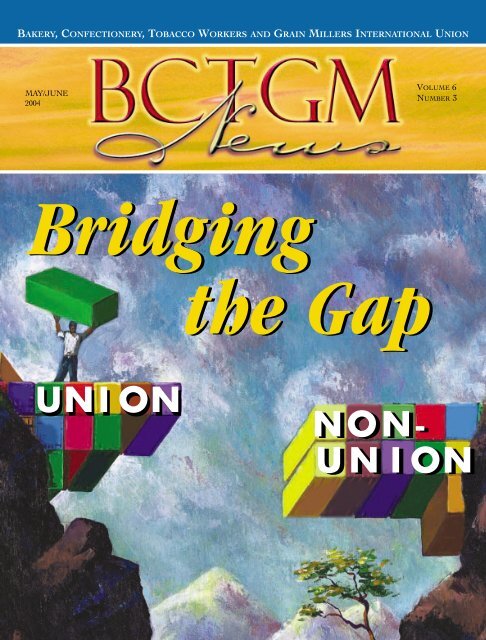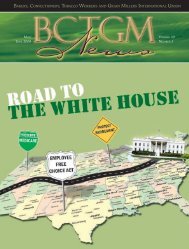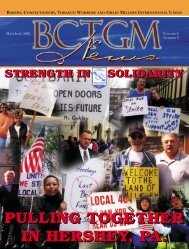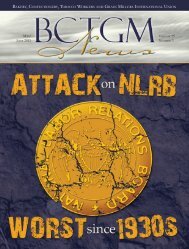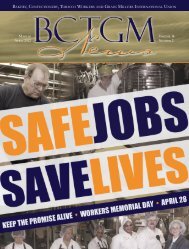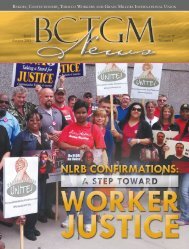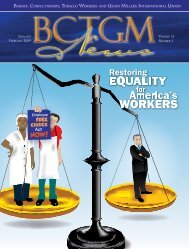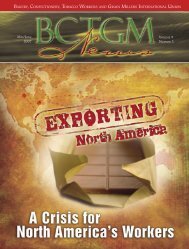to view/print. - BCTGM
to view/print. - BCTGM
to view/print. - BCTGM
- No tags were found...
Create successful ePaper yourself
Turn your PDF publications into a flip-book with our unique Google optimized e-Paper software.
BAKERY, CONFECTIONERY, TOBACCO WORKERS AND GRAIN MILLERS INTERNATIONAL UNIONMAY/JUNE2004VOLUME 6NUMBER 3Bridgingthe GapUNI ONNON-UN ION
theThe 2004 presidential campaignis already in high gear—a truly remarkable fact giventhat voters won’t go <strong>to</strong> thepolls for nearly five months. This is the earliest acampaign has reached this level of intensity inrecent memory, reinforcing our belief that the racewill be close and that the stakes are very high inthis election for all Americans.It is ironic that the Bush and Kerry campaignswill raise and spend millions for a job that pays thewinning candidate roughly one million dollars insalary over a four-year period. Considering bothcandidates are already multi-millionaires, there ismuch more involved than just the salary.Both candidates have spent tens of millions ofdollars, mostly on television advertisements, trying<strong>to</strong> persuade those of us without all the money how<strong>to</strong> vote. Outside organizations allied with either sideare spending millions more on ads.In the so-called “battleground states,” the onespolitical experts believe will be the closest, familieshave been bombarded by political commercials.That will only get heavier and broader in themonths ahead.In the end, the candidates—no matter howwealthy and well financed they are—still have <strong>to</strong>make their cases <strong>to</strong> the voters, most of whom areworking men and women. This is the strength ofour American democracy.Over the next five months, voters should take along, hard look at the announced and the hiddenagendas of both candidates who want <strong>to</strong> bePresident. Where does each one want <strong>to</strong> takeAmerica in the future and why? Which candidatemost strongly supports the interests of workingfamilies?The answers <strong>to</strong> these questions can be found inthe candidates’ positions on the critical issuesaffecting our members from their kitchen tables <strong>to</strong>the shop floor and in their union halls. Theirrespective positions are clear and starkly different.Every union member needs <strong>to</strong> analyze wherethe candidates stand on: protecting overtime pay,tax fairness, Social Security, outsourcing jobs overseas,trade policy, health care and prescription drugPresident’s MessageCRUCIAL CHOICEScoverage for all, controlling skyrocketing healthinsurance costs and protecting the fundamentalright of workers <strong>to</strong> form unions.Throughout the course of the campaign season,the <strong>BCTGM</strong> International will continue <strong>to</strong>provide our members with factual information onthe candidates and the issues so that they canevaluate which candidate is best for them, theirfamilies, our union and our nation.Detailed information will be available infuture editions of the <strong>BCTGM</strong> News as well as onour website, www.bctgm.org. I stronglyencourage all of our members <strong>to</strong> utilize this website.It is a tremendous source of information andpowerful <strong>to</strong>ol for getting involved in the politicalprocess.Nothing less than the future of our country isriding on the outcome of the November elections.Because <strong>BCTGM</strong> members and their familiescare deeply about America’s future, I am confidentwe will go <strong>to</strong> the polls in record numbersthis year.American democracy is strongest when voterturnout is highest. Working families do bestwhen our voice is the loudest on Election Day!Frank Hurt<strong>BCTGM</strong> International PresidentOfficial Publication of the Bakery, Confectionery, TobaccoWorkers and Grain Millers International Union10401 Connecticut Avenue, Kensing<strong>to</strong>n, Maryland 20895-3961(301) 933-8600www.bctgm.orgFrank Hurt, Edi<strong>to</strong>rCorrina A. Christensen, Assistant Edi<strong>to</strong>r<strong>BCTGM</strong> GENERAL EXECUTIVE BOARDPresident Frank Hurt • Secretary-Treasurer David B. Durkee • Executive Vice PresidentsJoseph Thibodeau • Larry Barber • Vice Presidents Jeanne Graham • Shawn J. Grimm •Harry A. Guildner • Anthony L. Johnson • Richard Johnson • Sean Kelly •Michael T. Konesko • Arthur Montminy • Robert Oakley • Randy Roark •Ronald D. Schreiber • T.J. Warren<strong>BCTGM</strong> GENERAL EXECUTIVE BOARD MEMBERSJoyce Als<strong>to</strong>n • Edward Burpo • Randy W. Fulk •Oscar B. Giles • Johnny Jackson • Micheline Labrecque • Paul LaBuda •Richard Lewis • Narcisco Martas • Herbert W. Marx • Danny Murphy •Brad Schmidt • William Sprandel • Doyle Townson<strong>BCTGM</strong> News (ISSN 1525-4860) is published bi-monthly by the Bakery, Confectionery, Tobacco Workers and Grain MillersInternational Union, 10401 Connecticut Avenue, Kensing<strong>to</strong>n, MD 20895-3961. Periodicals postage paid at Kensing<strong>to</strong>n, MD and at additionalmailing offices. Subscription <strong>to</strong> new members only. Postmaster: Send address changes <strong>to</strong> <strong>BCTGM</strong> News, 10401 ConnecticutAvenue, Kensing<strong>to</strong>n, MD 20895-3961.2<strong>BCTGM</strong> News
<strong>BCTGM</strong> Takes the Cake at the Union Industry Show“What does<strong>BCTGM</strong>stand for?”“I didn’t knowthat all theseproducts wereunion made!”TThe above statements were just someof what was heard around the<strong>BCTGM</strong>’s booth at the 2004 UnionIndustries Show at the St. LouisAmerica’s Center, St. Louis Mo.,April 23–26.Hundreds of <strong>BCTGM</strong>-made productsfrom nearly 50 union contractedcompanies helped bring life <strong>to</strong> theshow’s theme, “America at it’s Best.”With enough space <strong>to</strong> highlight productsmade by union members representinga diverse facet of the <strong>BCTGM</strong>,the expansive booth displayed everythingfrom bread, candy, cakes andcereals <strong>to</strong> flour and sugar.Visi<strong>to</strong>rs were openly wowed at thenumber of their favorite products producedby <strong>BCTGM</strong> members and weredelighted <strong>to</strong> participate in the raffles forbags of goods and professionally decoratedcakes.The Show features area unions andunionized employers, as well as nationalcompanies and international labororganizations, <strong>to</strong> underscore theirimportant contributions <strong>to</strong> the economicand social life of the American community.The 2004 show featured morethan 300 exhibits covering an areaequal <strong>to</strong> four football fields.As is the case each year, the<strong>BCTGM</strong> exhibit was the most visitedand enjoyed. An estimated 300,000 visi<strong>to</strong>rsattended the show with many ofthem s<strong>to</strong>pping by the <strong>BCTGM</strong>’s uniqueexposition where more than 1,200 grocerybags filled with the union’s productswere distributed.“This is myfavorite cereal!I’m so glad it ismade by yourunion!”May/June 2004 www.bctgm.org 3
Dianda’s Italian American Pastry Dianda’s, on Misson Street inSan Francisco, has been a unionbakery for more than 40 years. Pat Dianda, the last remainingfamily member still involved in thebusiness, delicately personalizes a St.Honore cake. The renowned specialtycakes are a Dianda family recipe. Everick Montilliano (left) has beena baker for more than 28 years. Everick Montilliano (left) addspowdered sugar <strong>to</strong> the cream puffswhile Francisco Fernandez (right) addscherry filling <strong>to</strong> the St. Honore cakes. <strong>BCTGM</strong> member and Dianda’s owner,Luis Pena, adds chocolate <strong>to</strong> a tray ofItalian butter cookies.The aroma of sweet baked Italianspecialties lures the senses outsideDianda’s Italian AmericanPastry in San Francisco’s brightand vibrant Mission District.Serving generations of SanFranciscans, this well-loved bakeryis known for its immense andbeautiful St. Honore cakes, delectablenut-and-fruit studded panforte,fedores, zabiones and morethan 20 different Italian pastriesand 35 different kinds of cookies.The small shop, a family businesssince Elio Dianda broughthis recipes from Lucca, Italy, isnow owned and operated by threemembers of <strong>BCTGM</strong> Local 24. Thebakery itself has existed since1906, when there were woodensidewalks and trains runningdown Mission Street, according <strong>to</strong>Pasquale “Pat” Dianda, the lastremaining family member stillinvolved in the business.His parents, Elio and Enrica,immigrated <strong>to</strong> the U.S. in 1954and bought the bakery in 1962.The bakery has been representedby the union since its inception“because you’d be shut down ifyou weren’t union. We’ve hadunion contracts from the verybeginning,” recalls Pat. “We’vealways believed that you take careof the people who work for you.”Last year, when Pat and histwo brothers decided that aftermore than 40 years they wantedout of the family business, theyapproached their workers, all<strong>BCTGM</strong> members with longtenures. Sergio Flores, Luis Penaand Floyd Goldburg bought the4<strong>BCTGM</strong> News
Delights San Franciscobakery and continue the Diandafamily’s legacy of Italian baking.Pat, now a Local 24 member,works three days a week <strong>to</strong> helpwith the transition.Pena, who has worked atDianda’s for 16 years, calls hisownership of the bakery a “wholenew and exciting experience.”Flores, a Dianda’s baker for morethan 23 years, says he sees owningthe bakery as “a challenge—but a challenge I’m glad we decided<strong>to</strong> take on.”As for the other Local 24 members,working at the bakery is alabor of love. Everick Montilliano,who has been a baker for morethan 28 years—19 at Dianda’s—sees the new ownership by Flores,Pena and Goldburg as a “naturaltransition. It is a great place <strong>to</strong>work where we all enjoy what wedo.”From intricately decoratedwedding cakes <strong>to</strong> meltingly tenderbiscotti, according <strong>to</strong> Local 24Financial Secretary Felisa Castillo,people from throughout the SanFrancisco Bay area travel <strong>to</strong> theMission Street bakery especiallyfor their baked goods. Mostfamous are the Dianda’s St.Honore cakes, which are as beautifulas they are delicious. “Peoplerealize that the bakers here aretruly artists,” notes Castillo.“The Dianda family createdone of this city’s best loved bakeries.We are really proud that theworkers and the owners will carryon not only the family name, butalso the <strong>BCTGM</strong> union tradition,”she concludes. Saturnino Gonzalez Villa meticiouslydecorates a St. Honore cake. Jose Rios glazes pana<strong>to</strong>nne, afestive Italian bread.Preparing pana<strong>to</strong>nne for theoven is Javier Luis Ramos. Sergio Flores, who has been aunion baker at Dianda’s for 23 years,is one of the bakery’s new owners. Ronoldi Omar Valencia putsfreshly baked cakes on<strong>to</strong> a coolingrack.May/June 2004 www.bctgm.org 5
Defend Workers’ Right <strong>to</strong> Join Unionsby U.S. Representative George Miller (D-Calif.)LLast fall, I introduced theEmployee Free Choice Act <strong>to</strong>guarantee American workers’right of freedom of associationand right <strong>to</strong> collectively bargain.The U.S. tells other nations thatthese rights are fundamental <strong>to</strong>any democracy. It’s time—in fact,it’s way past time—for workershere in the United States <strong>to</strong> havethe same rights and protectionswe demand of poorer, less developedand less democraticnations around the world.Unfortunately, the basic laborlaw that Congress enacted in1935 no longer works <strong>to</strong> protectthe right of workers <strong>to</strong> form andjoin unions. Recent his<strong>to</strong>ry is litteredwith the s<strong>to</strong>ries of companiesthat harassed, intimidated,discriminated against, or firedtheir workers when they sought<strong>to</strong> exercise their legal right <strong>to</strong>organize for their mutual benefit.Take Wal-Mart, whose vigorousanti-union activities rangefrom threats and firings <strong>to</strong>unlawful surveillance. In the lastfew years, Wal-Mart has beencharged with well over 100unfair labor practices and hasfaced at least 50 formal complaintsfrom the National LaborRelations Board. None of thishas apparently deterred Wal-Mart. Current law simply doesnot discourage lawbreakers.In August 2000, HumanRights Watch, which usuallyre<strong>view</strong>s conditions in developingnations, documented “a systemicfailure <strong>to</strong> ensure the most basicright of workers [in the UnitedStates]: their freedom <strong>to</strong> choose<strong>to</strong> come <strong>to</strong>gether <strong>to</strong> negotiate theterms of their employment withLocal 125 (SanLeandro, Calif.) VicePres. Ken Young(left) and Local 24(San Francisco) Bus.Agt. Alex Fox (center)discuss issuesof importance <strong>to</strong>the <strong>BCTGM</strong> with U.S.Rep. George Miller(D-CA) at a recentfund raiser.their employers.” No impartialobserver of our law could reachany other conclusion.It is no mystery why workerswant unions. Wages amongunion workers are 26 percenthigher than wages amongnonunion workers. Union workershave better pensions, betterhealth benefits, and better shorttermdisability coverage. Unionworkers have contracts that preventarbitrary firings.But because the deck isstacked against employees whowant <strong>to</strong> form a union, unions winonly half of elections. That’s whythe Employee Free Choice Actprovides for a new deck, not just anew deal. Under this bill, if themajority of employees sign authorizationcards designating a unionas their bargaining representative,then the NLRB must certify it astheir bargaining representative.The bill also includes provisions<strong>to</strong> ensure that a union is notderailed in its efforts <strong>to</strong> get a firstcontract with an employer. And itstrengthens penalties against companiesthat try <strong>to</strong> stymie unionorganizing activities or forestall afirst contract with a union. Onlyby making the consequences substantialfor companies that violatethe law can we expect workers’rights <strong>to</strong> be upheld.The Employee Free ChoiceAct res<strong>to</strong>res integrity <strong>to</strong> our laborlaw by ensuring that our own citizenshave the same basic freedomwe demand for others. Theright <strong>to</strong> organize must mean morethan the right not <strong>to</strong> be fired fordaring <strong>to</strong> propose a union, andthe right <strong>to</strong> bargain collectivelymust mean more than the right <strong>to</strong>endlessly negotiate once a unionhas been selected.This legislation is a fight <strong>to</strong>enable workers <strong>to</strong> defend themselves.It is an his<strong>to</strong>ric fight thatI will continue until the rights ofworking Americans are fullyprotected.U.S. RepresentativeGeorge Miller (D-Calif.)is the senior Democrat onthe House Education andthe Workforce Committee.6<strong>BCTGM</strong> News
FOUTH REGION DELEGATES PreparePOLITICAL ACTION and ORGANIZING PlansDDelegates <strong>to</strong> the 2004 FourthRegion Council Meeting inOrlando, Florida respondedenthusiastically <strong>to</strong> theInternational Union’s call formobilizing the membership forpolitical action and organizing.Recognizing the wide-range ofpolitical and economic issues facing<strong>BCTGM</strong> members, the Councilwill use the meeting as a springboardfor action on both fronts.<strong>BCTGM</strong> International PresidentFrank Hurt addressed themeeting, discussing the challengesconfronting the <strong>BCTGM</strong>. Hur<strong>to</strong>ffered a plan <strong>to</strong> help the unionmove forward for a better future.“Working families in thiscountry desperately need newpolitical leadership in Washing<strong>to</strong>n,”declared Hurt. “Wehave an Administration andCongress that have put in placea disastrous economic plan thathas destroyed millions of goodjobs while at the same time linedthe coffers of the wealthiest andlargest corporations.“The root cause of all of ourproblems can be traced rightback <strong>to</strong> politics. This year’s electionsare the most important inLocal 163 memberand shop stewardGerome Posey (left)discusses the problemsfaced by hismembers at the SaraLee plant inHous<strong>to</strong>n with<strong>BCTGM</strong> Intl. Pres.Frank Hurt.decades. I call on every <strong>BCTGM</strong>Local <strong>to</strong> work with theInternational like never before <strong>to</strong>take back America by electingcandidates who will supportworking men and women,” concludedHurt.Delegates also focused on theimportance of bringing newmembers in<strong>to</strong> the union as ameans of making the <strong>BCTGM</strong>stronger at the bargaining tableand in the political arena.International officers and representativesworked with the delegateson strategies for organizingnon-union plants and signing upnon-union workers in <strong>BCTGM</strong>organized shops.In addition <strong>to</strong> Hurt, otherspeakers included: InternationalSecretary-Treasurer and Direc<strong>to</strong>r ofOrganization David B. Durkee,International Executive VicePresident Joseph Thibodeau,Assistant <strong>to</strong> the President HarryKaiser, Pension Fund ManagerLew Davis, and President of theCentral Florida Labor CouncilDeborah Booth.In assessing this year’sCouncil meeting, Fourth RegionVice President Tony Johnsonstated, “The local unions in theFourth Region are unified andenergized <strong>to</strong> tackle the challengesbefore us. We know thestakes are high in this year’selections. We understand, aswell, that building the membershipthrough organizing is theonly way <strong>to</strong> secure solid contractsfor our members. I’m confidentwe’ll get the job done.”Delegates <strong>to</strong> the 2004<strong>BCTGM</strong> Fourth RegionCouncil, <strong>BCTGM</strong>Executive officers andInternational Staff.May/June 2004www.bctgm.org7
GIVE OUR KIDS A BREAK:This is a troubling time forAmerica’s school children,Duringtheir parents and the peoplewho are most intimately connectedwith our public school system.The budget crises in thestates, the worst since World WarII, are causing cutbacks that willhave a negative effect on studentsand schools for years <strong>to</strong> come.Class sizes will rise if threatenedteacher layoffs occur. Summerschool and after school programs,so important <strong>to</strong> children who need<strong>to</strong> catch up, are disappearing,along with music and art. Nurses,hearing specialists, paraprofessionals,and even cus<strong>to</strong>dial staffare being slashed.“Public education is the foundationupon which a prosperousnation is built. It creates opportunityfor all children regardlessof class, race or religion. That iswhy the federal government hasbeen actively involved in thepublic education system sincethe earliest days of our country,”explains <strong>BCTGM</strong> President Hurt.FACTS:the past three fiscal years (FY 2001–FY 2003,which ended June 30), state governments have scrambled<strong>to</strong> find $200 billion <strong>to</strong> close record budget gaps. Despite drastic cost cuttingat every level of every state government, the future looks grim: 41 statesare facing a cumulative budget gap of $85 billion for the upcoming fiscal year,according <strong>to</strong> estimates by the National Conference of State Legislatures.Because most states’ tax laws are tied <strong>to</strong> federal tax regulations, states losteven more revenue when they were forced <strong>to</strong> match the Bush Administration’s2001 $1.35 trillion tax cut for millionaires. States also will be forced <strong>to</strong> matchmuch of Bush’s $350 billion tax cut bill he signed in<strong>to</strong> law a year ago.Children are losing out on education, with some 20 states cutting publicschool funding from kindergarten through grade 12 and many state universitiesand colleges raising tuition and fees.As the states and districtsstruggle with massive budgetshortfalls, they are being hit withyet another financial burden—the federal No Child Left BehindAct (NCLB). The law’s goals arefine: high standards for all children,with tests <strong>to</strong> measurewhether the standards are beingmet and help for students andschools that are lagging behind.The problem is that federal dollarsneeded <strong>to</strong> realize these loftyAs school buildings crumble, class sizes swell and educational programs arecut, President Bush continuously proposes policies that impose costly newrequirements on states without providing the new funding needed <strong>to</strong> meetthem. Additionally, he has failed <strong>to</strong> provide adequate assistance <strong>to</strong> help statesavoid deep cuts in education funding in response <strong>to</strong> their dire budget crises.In pushing the 2001 education reform bill, Bush promised the nation therewould be “no child left behind”—a phrase he co-opted from the Children’sDefense Fund, which works <strong>to</strong> improve the quality of life for children. Butwhile requiring states <strong>to</strong> meet costly new standards, the No Child Left BehindAct is sorely underfunded—so much so that Republican state legislaturesacross the nation have considered going without federal funds al<strong>to</strong>gether.goals are woefully inadequate.While President Bush has proposeda budget that exceeds twotrillion dollars, it unfortunatelydoes little <strong>to</strong> support public education,eliminating 35 programs,cutting or freezing many others,and overall providing just a 2.8percent increase, the smallestincrease in seven years. Perhapsthe most troubling aspect of thePresident’s budget is that itspends 50 times more on additionaltax cuts for the America’swealthiest (<strong>to</strong>p one percent) thanit does on education.A report by the AmericanFederation of Teachers shows initiatives<strong>to</strong> help students is gettingcrushed amid the states’ budgetcrises. Summer school programsfor struggling students have beencut in school districts in 22 states.Washing<strong>to</strong>n must do muchmore. The American public hasrepeatedly said that it wants education<strong>to</strong> be one of the highestdomestic priorities. Cutting educationfunding for vital programsthat work and that have helped<strong>to</strong> raise student achievement isthe wrong way <strong>to</strong> go.8<strong>BCTGM</strong> News
Matching Promises with CommitmentCollege TuitionPercent Increase in Public Four-Year Tuition and Fees(2001–02 <strong>to</strong> 2002–03)Increase in Tuition2–5%6–10%11–24%AKWA0RNVCAIDAZUTMTWYCONMNDSDNEKSOKTXMNIAMOARLAWIILINTNMIKYOHMS AL GAWVSCFLPAVANCNYVTMENHMACT RINJDEMDSource: NationalCenter for PublicPolicy & HigherEducationHIWWhile high schoolstudents are makingimportant decisionsabout which college is best forthem, the decision for many islimited, not by their desire, talent,academic ability or testscores, but by skyrocketing educationalcosts even at state collegesand universities. Sadly, acollege education in the U.S. isbecoming a luxury.Union and middle-class familiesare spending a larger percentageof their incomes just <strong>to</strong>keep pace with rising collegetuition. Today, the average costfor attending a public four yearcollege is about $9,000. For aprivate four-year institution,costs are nearly $24,000. Toattend one of the best stateschools, it costs nearly 20 percen<strong>to</strong>f the average familyincome. It costs up <strong>to</strong> 40 percen<strong>to</strong>f average family income for oneof America’s <strong>to</strong>p private colleges.In some cases, families arespending more each year <strong>to</strong> sendjust one child <strong>to</strong> school than theyare in mortgage payments.“State colleges and universitiesare the great equalizer in oursociety. They enable the sons anddaughters of workers <strong>to</strong> achievethe same goals as the sons anddaughters of wealthy employers.Government policies that resultin working families being pricedout of public colleges are anunacceptable road block <strong>to</strong> equalopportunity for young middleclassmen and women,” statesHurt.Too many middle-class unionfamilies are caught in the visebetween trying <strong>to</strong> save for retirement,helping elderly parents withprescription drug costs or long-termcare, and coping with the rapidincrease in tuition costs that put acollege education out of reach.The <strong>BCTGM</strong> believes that ourelected officials need <strong>to</strong> strengthenevery aspect of tuition creditsand assistance for hard-workingfamilies, whether it is tax deductions,tax credits, student loaninterest deductions, employerprovidededucational assistance,or merit scholarships.According <strong>to</strong> a nationalstudy on higher educationjust released, families arelosing ground. The fivetrends cited in the reportshow a bleak picture oftwo Americas. One is anation of privilege. Theother is a nation ofdeb<strong>to</strong>rs struggling <strong>to</strong>compete. The report said,“federal and state financialaid <strong>to</strong> students hasnot kept pace withincreases in tuition.”May/June 2004www.bctgm.org9
The <strong>BCTGM</strong> WebInternational and Local UnionWeb Sites Build SolidarityFrom worker news throughout the U.S. and Canada and<strong>BCTGM</strong> organizing vic<strong>to</strong>ries, <strong>to</strong> health and safety laws andimportant legislative issues, www.bctgm.org is a valuableresource for union members andtheir families.Taking part in thePolitical ProcessThe most interactive resource ofthe International’s site is theLegislative Action Center. Thisextensive political action section ofthe site allows visi<strong>to</strong>rs <strong>to</strong> directly e-mail members of Congress cus<strong>to</strong>mletters and keeps track of pendinglegislation and voting records.Other special features of theLegislative Action Center includes:• Election 2004: Fromdetailed candidate bios <strong>to</strong>voter registration forms andservices, <strong>to</strong> information aboutspecific ballot initiatives, the<strong>BCTGM</strong> Legislative ActionCenter provides extensiveinformation for all aspects of the 2004 elections.• Zip Code Search <strong>to</strong> identify elected representatives.• E-mail Congress, the President and governmen<strong>to</strong>fficials.• Congressional Direc<strong>to</strong>ry• Daily Congress Schedule• Bill Status/Sponsor Tracking• Congressional Vote ScorecardLocals OnlineThe home pages of <strong>BCTGM</strong> local union web sites are asdiverse as our membership. From simple pho<strong>to</strong>s and localnews <strong>to</strong> extensive organizing and bargaining updates,<strong>BCTGM</strong> local unions throughout North America areincreasingly using technology <strong>to</strong> communicate with membersand build solidarity. Here are some sites <strong>to</strong> check out:Did You Know…Entire issues of the<strong>BCTGM</strong> NEWS can be downloadedfrom the <strong>BCTGM</strong>International web site?Simply visitwww.bctgm.org/news/bctgm_newsindex.html<strong>to</strong> download and <strong>print</strong> any<strong>BCTGM</strong> NEWS issue between2002 and 2004.10<strong>BCTGM</strong> News
— Local 19: Cleveland, Ohio —www.bctgmlocal19.comLocal 19 proudly traces its his<strong>to</strong>ry back <strong>to</strong> itscharter in 1886. The Local 19 site has a calendar ofevents, an organizing page, contract updates and apho<strong>to</strong> album. According <strong>to</strong> Local 19 President PaulLaBuda, the site’s popularity is growing, especiallywith the local’s active retiree group.— Local 358: Richmond, Va. —www.bctgmlocal358.com“United we Stand, Divided we fall. Unity is thekey <strong>to</strong> our success!” declares the opening banneron the site. The Local 358 site includes email links<strong>to</strong> its officers, a pho<strong>to</strong> collection, meeting schedulesand an extensive list of links. According <strong>to</strong> Local358 President Ray Daniels, while the site is stillbeing developed, membership response has beenpositive and enthusiastic.— Local 359T: Hopewell, Va. —www.359t.orgPacked tightly with information, this site is for<strong>BCTGM</strong> members employed by Philip Morris. Fromretirement information, contracts and bylaws, <strong>to</strong>shift calendars and s<strong>to</strong>ck prices and company news,the Local 359T site lets you know what’s what andwho <strong>to</strong> call about almost anything from workplacebenefits and Philip Morris programs.— Local 406: Monc<strong>to</strong>n, New Brunswick —www.bctgm406.com“A Union for the Working Class,” proclaims theopening banner on Local 406’s site. The “OurHis<strong>to</strong>ry” section provides an extensive scrolling lis<strong>to</strong>f his<strong>to</strong>rical dates in <strong>BCTGM</strong> his<strong>to</strong>ry and the “LocalNews” section features the current and past issuesof The 406 News Brief newsletter of the local.Other <strong>BCTGM</strong> Locals on the WebLocal 154G: London, Ontariowww.bctgm154.caLocal 283G: Twin Falls, Idahowww.northrim.net/wyanders/bctgmLocal 317T: Greensboro, N.C.http://317t.comLocal 362T: Macon, Ga.www.mindspring.com/%7Ebct362t/BCT/index.htmLocal 446: Halifax, Nova Scotiawww.bctgm.ns.caDon’t see your local listed? Send a link <strong>to</strong>your site <strong>to</strong> bctgmwebmaster@bctgm.org!May/June 2004www.bctgm.org11
Local Union Officers Train for FutureTThe first of two week-long trainingsessions for new local officers<strong>to</strong>ok place in March at theGeorge Meany Center for LaborStudies, in Silver Spring, Md. Theprograms, administered by the<strong>BCTGM</strong> International Research& Education Department, aredesigned <strong>to</strong> give new local officersa basic over<strong>view</strong> of the coresubjects critical <strong>to</strong> running asmooth and efficient local union.The program opened with anaddress by <strong>BCTGM</strong> InternationalPresident Frank Hurt, who highlightedthe importance of buildingstrong local unions throughstrong leadership. “Education isan important fac<strong>to</strong>r in creating apowerful, mobilized membershipboth locally as well as internationally,”said Hurt.Participants engaged in a mixof lectures, interactive exercises,and group projects. Differentspeakers instructed the class onlabor law, health and safety, contractwriting, and contract<strong>BCTGM</strong> Intl. Pres.Frank Hurt highlightsthe importanceof buildingstrong localsthrough education.Fourteen new local officers successfully completed theInternational’s New Officers Training course at the George MeanyCenter for Labor Studies in Silver Spring, Md. in March.During a <strong>to</strong>ur ofunion headquarters,the officersvisit <strong>BCTGM</strong> Intl.Secy.-Treas./Dir. ofOrganization DavidB. Durkee, whostresses the importanceof organizing.enforcement. Financial secretariesparticipated in special sessionsthat focused on local unionrecord-keeping and newDepartment of Labor reportingrequirements. In addition, theclass <strong>to</strong>ok part in different groupexercises that focussed on organizingand corporate research, andutilized Internet research andcomprehensive planning skills.To many members, the highligh<strong>to</strong>f the week is the interactionwith other local union officers.All participants had thechance <strong>to</strong> compare experiences,discuss strategies, and shareunique ways <strong>to</strong> deal withdemanding situations. According<strong>to</strong> Hurt, the interaction is vital forthe new officers, as they realizelocal unions in the East are facingthe same challenges as localunions in the West. “It makes thebond of our union family thatmuch stronger,” added Hurt.Graduates of the spring programinclude: Guy Jacobo (Local125, Oakland, CA), Ray DanielsJr. (Local 358, Richmond, VA),Nikee Craine, (Local 326, Detroit,MI), Ed Blair (Local 401G,Munch, PA), Tom Kelly (Local 25,Chattanooga, TN), Mike Meier(Local 13G, Hastings, MN), SteveUnderwood (Local 48G, Keokuk,IA), Achmed Achtau (Local 719,Fairlawn, NJ) Frank Guzman(Local 466, Billings, MT), ScottWells (Local 342, Blooming<strong>to</strong>n,IL), Marquerita Dugger (Local255T, Petersburg, VA) RonPernick (Local 194G, Tren<strong>to</strong>n,MO), Jeff Brown (Local 194G,Tren<strong>to</strong>n, MO) and Walter Howard(Local 300, Chicago, IL).12<strong>BCTGM</strong> News
A Family His<strong>to</strong>ry of Union MembershipIIt is often said that union membership“runs in the blood.”Generations of union membersshare the same last name and apassion for the labor movement.Just ask retired <strong>BCTGM</strong> Local118 (Washing<strong>to</strong>n D.C.) memberFrancis Spaulding. His fatherbegan a legacy of bakery unionmembership that was carried onby both Francis and his brotherJack Spaulding Jr. Collectively,the Spaulding men have writtenmore than 100 years of unionmembership in<strong>to</strong> the <strong>BCTGM</strong>his<strong>to</strong>ry books.For John “Jack” Spaulding Sr.,his lifelong career as a unionbaker began out of necessity <strong>to</strong>support his young family. Born inApril 1887, Jack was an outstandingathlete and in the early 1900she followed his passion of baseballin<strong>to</strong> the minor leagues wherehe played for the PiedmontLeague of Virginia. Jack was alsoa boxer and spent a short time“barns<strong>to</strong>rming” his wrestlingshow in <strong>to</strong>wns throughout theNorth and South.During a recent trip <strong>to</strong><strong>BCTGM</strong> International headquarters,Francis recalled someof the s<strong>to</strong>ries of his father’syouth. “When my father wasn’tplaying baseball or wrestling,he worked in a bakery ownedby his Uncle Jimmy. He liked<strong>to</strong> keep in shape so he workedout at a gym on PennsylvaniaAvenue. It was at this samegym that U.S. President TeddyRoosevelt would come andwork out. On several occasions,my father sparred withPresident Roosevelt in the boxingring. He <strong>to</strong>ld me he was a<strong>to</strong>ugh cus<strong>to</strong>mer in the ring andI understand he was a <strong>to</strong>ughguy out of the ring <strong>to</strong>o!”As Jack Sr.’s family began <strong>to</strong>grow, he had <strong>to</strong> quit playing baseball.He went <strong>to</strong> work at Homes ToHomes Bakery in NorthwestWashing<strong>to</strong>n D.C. in 1907. At thattime, Holmes delivered bakedgoods by horse and buggy. Assoon as they were old enough,Jack Sr.’s sons, Francis and Jack Jr.joined Local 118 and went <strong>to</strong> workThe proud bakers of Local 118 gather around the inaugural cakethey prepared at Heidi Bakery for President Carter. At left areEugene Fentress, Phil Harich and Herb Sison. Kneeling, from left, areDave Pollard, Fred Harich, Melvin Kaye, Karl Koopman and FrancisSpaulding. At right are Frank Streeks, Mike Konik and George Aguilar.with their father at the Holmesbakery. Jack Sr. retired from thebaking business in 1955 whenHolmes went out of business.According <strong>to</strong> Francis, his fatherwent on <strong>to</strong> work as an usher atGriffith Stadium and RFK Stadiumand even scouted new baseballplayers for the Detroit Tigers. JackSr. passed away in 1980.Jack Jr. and Francis continuedin the baking industry and workedat the Heidi Bakery (Giant Food)in Washing<strong>to</strong>n. While not havingpersonal contact with any U.S.Presidents, Francis proudly notesthat as a member of <strong>BCTGM</strong>Local 118 he helped bake anddecorate inaugural cakes for twoDemocratic Presidents.According <strong>to</strong> Francis, whohas survived both his father andhis brother, “Being a member ofthis union has played a large rolein shaping who my family was. Itwas a proud tradition of unionmembership we all enjoyed,” heconcludes.May/June 2004www.bctgm.org13
On April 18, <strong>BCTGM</strong>Local 25 (Chattanooga,Tenn.) membersemployed by RichProducts ManufacturingCorp. in Murfreesboro,Tenn. celebrated theirone-year anniversary withthe <strong>BCTGM</strong>. To commemoratethe event, unionmembers and their familiesgathered for a ban-ANNIVERSARY CELEBRATIONquet at the Lions Clubhall. According <strong>to</strong> Local 25 Business Agent Tommy Kelly, it was a very festive event that included homemade food,door prizes and plenty of union fellowship. “These people represent everything that a union stands for. The membershiparranged this dinner and made it a huge success. I am proud <strong>to</strong> be associated with this group of peopleas we move forward <strong>to</strong> reach our goal of one hundred percent union membership in this plant,” concludes Kelly.<strong>BCTGM</strong>-PACLocal 9 (Seattle) Fin. Secy.Robert Davis (right) presentsU.S. Sen. Patty Murray (D-Washing<strong>to</strong>n) with a <strong>BCTGM</strong>-PAC donation in support of herre-election campaign. Murrayhas a long record of voting insupport of labor issues.Following recentcontract negotiationswith ConAgra,<strong>BCTGM</strong> Intl. Rep. DanGust and the Local143G (Rapid City,S.D.) negotiationscommittee membersmet with U.S. Sen.Tom Daschle (D-S.D.)in his district office.POLITICAL ACTIONPictured here (fromleft <strong>to</strong> right) is L. 143G Pres. Wes Jamison, Daschle, Steward KellyStephens, L. 143 Vice Pres. Dana Deville, Gust, and Steward Terry Hulce.EDUCATION & MOBILIZATION Pictured here is a group of Local317T (Greensboro, N.C.) stewards who attended a shop stewards seminarin February taught by Intl. Rep. Barry Baker. Topics covered included grievancehandling, organizing, political action, the 2004 presidential electionsand more.14<strong>BCTGM</strong> News
<strong>BCTGM</strong> Power Union Plus Mortgage &Real Estate makes refinancing and homebuyingeasier and more affordable forworking families. Through ChaseManhattan Mortgage Corporation, one ofthe largest lenders in the U.S., unionmembers can take advantage ofconvenient mortgage programs. Take alook at some of the benefits:Union PlusMortgage &Real EstateHome Financing Made SimpleVisit the Home Finance Center online atwww.bctgm.org/benefits/index.htm for firsttimehome buyers’ support, planning calcula<strong>to</strong>rsand information about the entire mortgageprocess. You can also call the <strong>BCTGM</strong>Power/Union Plus Mortgage and Real Estateat: 1-800-416-5786. A program counselor willanswer all of your home-buying questions—from how much house you can afford, <strong>to</strong>what type of mortgage will best suit yourneeds. They can also refer you <strong>to</strong> a professionalreal estate agent who can help you finda home within your price range.Call <strong>BCTGM</strong> Power/Union Plus Mortgageand Real Estate at:1-800-416-5786• Easy application process on thephone or in-person;• Strike and unemployment/disabilitybenefits <strong>to</strong> help you make paymentswhen you’re out of work;• Mortgage loans <strong>to</strong> purchase orrefinance your home;• For refinancing: You could loweryour rate, lower your monthlypayments and shorten your loanterm;• Mortgage programs for borrowerswith “less than perfect” credit;• Your family—including parents andchildren—are also eligible for UnionPlus mortgages;• Down payments as low as 5%—andeven lower for qualified buyers;• $350 <strong>to</strong>ward closing costs (for buyerswho use both the real estate andmortgage portions of the program);• The average maximum lender feeunder the Union Plus program is only$100, compared <strong>to</strong> an industryaverage of $753 in fees, based on anational survey of mortgage lenderfees by HSH Associates in May 2003.So union members save an averageof $653.May/June 2004 www.bctgm.org 15
The Union DifferenceQuiz1How much higher arethe median weeklyearnings of union workerscompared with nonunionworkers? a.6 percent b. 12 percent c. 26 percent2What percent of unionworkers gets healthbenefits? a. 75 percent b. 60 percent c. 28 percent3What percent ofnonunion workers getshealth benefits? a. 73 percent b. 60 percent c. 49 percentDoYouKnowtheUnionDifference?4What percent of unionworkers gets a guaranteed,defined-benefit pension? a. 19 percent b. 49 percent c. 69 percent5What percent ofnonunion workers gets aguaranteed, defined-benefitpension? a. 60 percent b. 27 percent c. 14 percent6What percent ofnonunion workers whoaren’t managers says theywould vote for union in theirworkplace? a. 17 percent b. 30 percent c. 47 percentSources: U.S. Department of Labor, Employment and Earnings, January 2003; Bureau of Labor Statistics, Employee Benefits inPrivate Indusry, 2000; Peter D. Hart Research Associates, February 2003.Answers: 1. c; 2. a; 3. c; 4. c; 5. c; 6. cPrinted in U.S.A.


